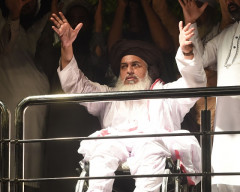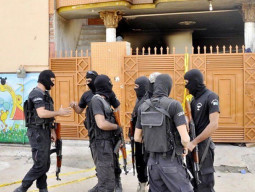
Traditionally, a population living in any geographical area provides a perfect refuge and a best camouflage capability to an intelligence operator or a terrorist. It is, therefore, important to control the population for gaining strategic and operational edge over one’s adversary. Mao Zedong, the famous Chinese statesman, military strategist and writer, says that an operator must move among the people as a fish swims in the water. In today’s environment, digital data and cyberspace provide a similar option to a terrorist to hide under fake identities while sharing plans, recruiting human resource and impacting tender hearts and minds on the internet. An external invasion to influence population means that one does not have to be physically in charge of the situation in a target country but he or she can easily manipulate the people and cause dissension and disturbance for state authorities through instigation and agenda setting by digital means. It will be, in a way, a kind of war without engagement and a victory without defeat. Interestingly in almost all major terror incidents in Pakistan, local population was used effectively for support and refuge, directly or indirectly, by terror operators or their handlers.
An analysis of terror-related incidents suggests that people of a locality support and facilitate a terrorist or terrorists on account of four main reasons. These include ethnic, geographical, sectarian and financial grounds. The most effective and strongest affiliations among population based facilitations happen to be sectarian and ethic leanings. Usually, in such situations the local population provides longer duration assistance with variegated aiding mechanism. In urban centres, where one can easily disappear among population and hide in high residential density it becomes immensely difficult to detect a terror operator if the latter finds a convenient population cover on ethnic or sectarian basis. The ethnic population composition and concentration in a city highlights probable sources of hideouts for terror elements. Such areas should, therefore, be examined and documented to deny the terror operators any space which can be used for running sleeper cells in the heart of a city.
Similarly, sectarian-based religious assemblies and residential colonies or groupings also indicate probable places of camouflage for the perpetrators of terrorism. A sectarian union with a terror operator is another lethal combination. Here the facilitator assumes a kind of religious responsibility to provide full protection to a terrorist. He or she even lays down his or her life in such protection and facilitation duty. The faith-based association makes it expedient for the terror operator to vanish among local population for a prolonged period of time and maintain sleeper cells accordingly. Whereas in rural zones, due to sparsely-populated area, the chances of identification and pointation become easier and resultantly the duration of support also shrinks accordingly.
For example, in the November 2018 Chinese consulate attack in Karachi, the terrorists used a house in Baldia Town Karachi for storing weapons and other material whereas the local population provided a perfect refuge to these elements who were able to disappear among the local population without any detection and identification on the basis of ethnic or geographic affinity. Similarly, in a recent attack conducted in Loralai, in which police officials and civilians lost their lives, the miscreants used local support to perpetrate such activity for a limited period owing to rural set-up and thin population concentration.
Moreover, an attack in Lahore in 2017, in which scores of policemen were killed, was conducted by a suicide bomber from Swat who used a local seminary where students from same geographical area were present for refuge and protection. The deadly attack claimed 26 lives along with causing injuries to more than 50 people in the vicinity of Arfa Karim Tower on main Ferozepur Road. Besides geographical affinity, in this particular attack, the ideological factor also played an important part since transportation and accommodation were also provided by students of the seminary.
The facilitation in majority of terror incidents in Punjab is based on sectarian lines in which local population extended support to such elements on similar basis which includes transportation, accommodation and financial assistance as well. For example, the attack on Data Darbar in July 2010 in which multiple suicide bombings were carried out at the venue of a Sufi saint the suicide bombers were provided protection on religious grounds to conduct such attack in the heart of the city. Similarly, a terror attack on a religious procession in Lahore in September 2010, which claimed lives of 27 persons with more than 200 injured, the facilitation was once again provided on sectarian basis to suicide bombers.
The anti-state elements, therefore, focus their attention on the population of target countries and use various mechanisms to goad them for probable support. Often, member or members of a family are convinced to cross the border and settle in a foreign territory by exploring their ethnic, tribal and contiguous-geographical-boundary mechanism in a region for direct contact for facilitation. Apart from providing technical expertise and psychological padding, the personal losses and misfortunes of a person are also exploited to conduct an attack through active population support. The Mastung suicide attack in July 2018 in which more than 150 persons were killed and many injured was carried out by a suicide attacker from Abbottabad who was residing in Sindh for many years. The suicide attacker spent nearly two years in Afghanistan with his family members before coming to Balochistan through irregular tracks and perpetrated a major terror incident in Balochistan. He was provided shelter on the basis of ethnic-religious proclivities in Mastung. Moreover, local support assisted him to reach the public meeting place to carry out the activity successfully.
In the age of digital communication, a terror operator hidden among digits is as difficult to detect as his or her diffusion among local population. Nonetheless, to conduct a terror action some kind of local aid is necessary for its success and operational viability. Documenting the population is one of the most effective ways to minimise such support along with employing population-based irregular surveillance mechanisms.
Published in The Express Tribune, February 12th, 2019.
Like Opinion & Editorial on Facebook, follow @ETOpEd on Twitter to receive all updates on all our daily pieces.





















































COMMENTS
Comments are moderated and generally will be posted if they are on-topic and not abusive.
For more information, please see our Comments FAQ